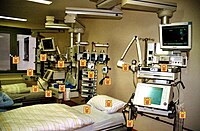
Photo from wikipedia
Background Infectious diseases are a significant threat in both healthcare and community settings. Healthcare associated infections (HCAIs) in particular are a leading cause of complications during hospitalisation. Contamination of the… Click to show full abstract
Background Infectious diseases are a significant threat in both healthcare and community settings. Healthcare associated infections (HCAIs) in particular are a leading cause of complications during hospitalisation. Contamination of the healthcare environment is recognised as a source of infectious disease yet the significance of porous surfaces including healthcare textiles as fomites is not well understood. It is currently assumed there is little infection risk from textiles due to a lack of direct epidemiological evidence. Decontamination of healthcare textiles is achieved with heat and/or detergents by commercial or in-house laundering with the exception of healthcare worker uniforms which are laundered domestically in some countries. The emergence of the COVID-19 pandemic has increased the need for rigorous infection control including effective decontamination of potential fomites in the healthcare environment. This article aims to review the evidence for the role of textiles in the transmission of infection, outline current procedures for laundering healthcare textiles and review studies evaluating the decontamination efficacy of domestic and industrial laundering. Methodology Pubmed, Google Scholar and Web of Science were searched for publications pertaining to the survival and transmission of microorganisms on textiles with a particular focus on the healthcare environment. Results A number of studies indicate that microorganisms survive on textiles for extended periods of time and can transfer on to skin and other surfaces suggesting it is biologically plausible that HCAIs and other infectious diseases can be transmitted directly through contact with contaminated textiles. Accordingly, there are a number of case studies that link small outbreaks with inadequate laundering or infection control processes surrounding healthcare laundry. Studies have also demonstrated the survival of potential pathogens during laundering of healthcare textiles, which may increase the risk of infection supporting the data published on specific outbreak case studies. Conclusions There are no large-scale epidemiological studies demonstrating a direct link between HCAIs and contaminated textiles yet evidence of outbreaks from published case studies should not be disregarded. Adequate microbial decontamination of linen and infection control procedures during laundering are required to minimise the risk of infection from healthcare textiles. Domestic laundering of healthcare worker uniforms is a particular concern due to the lack of control and monitoring of decontamination, offering a route for potential pathogens to enter the clinical environment. Industrial laundering of healthcare worker uniforms provides greater assurances of adequate decontamination compared to domestic laundering, due to the ability to monitor laundering parameters; this is of particular importance during the COVID-19 pandemic to minimise any risk of SARS-CoV-2 transmission.
Journal Title: PeerJ
Year Published: 2020
Link to full text (if available)
Share on Social Media: Sign Up to like & get
recommendations!